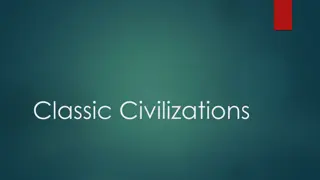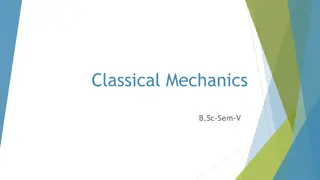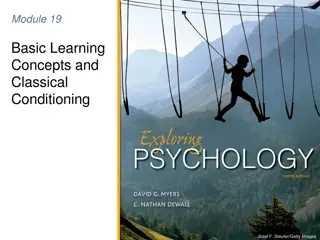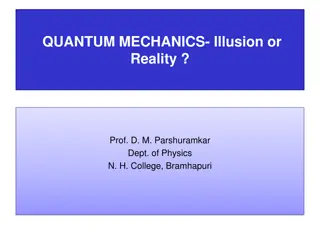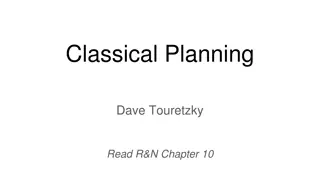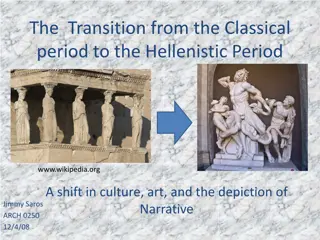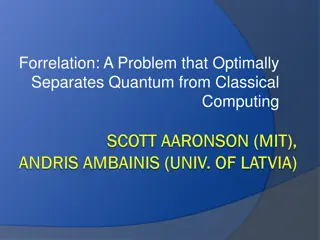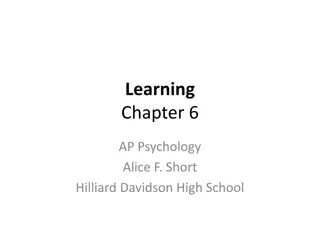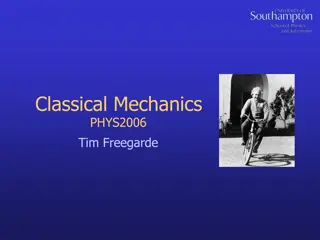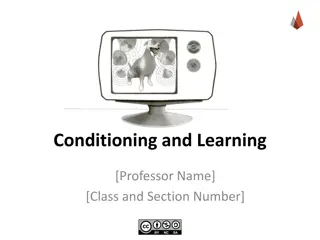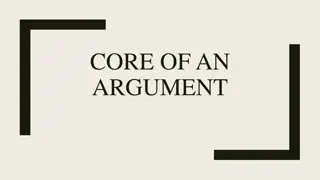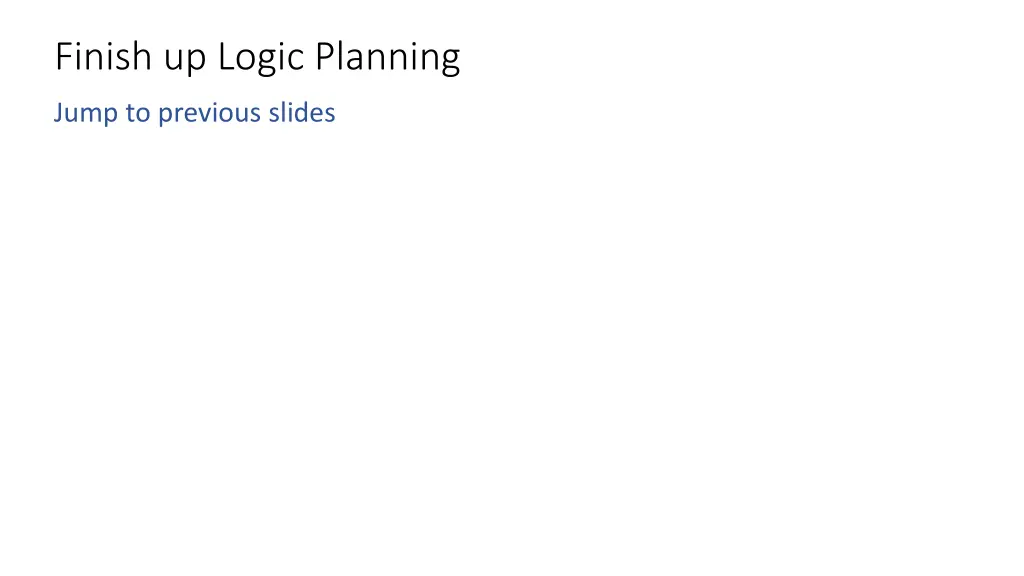
Logic Planning for Blocks World Problem Solving
Explore the concepts of logical planning in solving Blocks World problems, where a robot arm can pick up and put down blocks to create stacks. Learn about different planning strategies and how to represent the world for effective problem-solving. Dive into classical planning, symbolic planning, and more to enhance your understanding of AI problem-solving techniques.
Download Presentation

Please find below an Image/Link to download the presentation.
The content on the website is provided AS IS for your information and personal use only. It may not be sold, licensed, or shared on other websites without obtaining consent from the author. If you encounter any issues during the download, it is possible that the publisher has removed the file from their server.
You are allowed to download the files provided on this website for personal or commercial use, subject to the condition that they are used lawfully. All files are the property of their respective owners.
The content on the website is provided AS IS for your information and personal use only. It may not be sold, licensed, or shared on other websites without obtaining consent from the author.
E N D
Presentation Transcript
Finish up Logic Planning Jump to previous slides
AI: Representation and Problem Solving Classical Planning or Symbolic Planning Instructor: Pat Virtue Slide credits: CMU AI
Represent this Blocks World A robot arm (yellow) can pick up and put down blocks to form stacks. It cannot pick up a block that has another block on top of it. It cannot pick up more than one block at a time. Any number of blocks can sit on the table. How would solve Blocks World problems with search, e.g., BFS?
Represent this Blocks World A robot arm (yellow) can pick up and put down blocks to form stacks. It cannot pick up a block that has another block on top of it. It cannot pick up more than one block at a time. Any number of blocks can sit on the table. How would solve Blocks World problems with logical planning?
Search, Logic, and Classical Planning Search Planning Assumes actions and transitions are provided for you, s = result(s, a) State changes as you take actions Propositional Logic Planning Can reason about what actions are possible and their effects Represent world with only Boolean symbols Different symbols for different time points Classical Planning Can reason about what actions are possible and their effects State changes as you take actions
Idea of Classical Planning Represent objects/values separately from the state (instances) Define predicates as true/false functions over the objects (propositions) States are conjunctions of predicates Goals are conjunctions of predicates Robot Arm Operators (actions) A B C
Poll 1 Which predicates apply to this state? (Select all that apply) Instances: A, B, C Predicates: 1) In-Hand(A) 2) In-Hand(B) 3) In-Hand(C) 4) On-Table(A) C A B 5) On-Table(B) 6) On-Table(C) 7) On-Block(B,C) 8) On-Block(A,B) 9) HandEmpty()
Poll 1 Which predicates apply to this state? (Select all that apply) Instances: A, B, C Predicates: 1) In-Hand(A) 2) In-Hand(B) 3) In-Hand(C) 4) On-Table(A) C A B 5) On-Table(B) 6) On-Table(C) 7) On-Block(B,C) 8) On-Block(A,B) 9) HandEmpty()
Full State Description Instances: A, B, C Predicates: In-Hand(C) On-Table(B) On-Block(A,B) Clear(A) C A B Clear(C) Optional: ~HandEmpty(), ~On-Table(C), ~On-Table(A), ~On-Block(B,A), ~On-Block(C,A), ~On-Block(B,C), ~On-Block(C,B), ~On-Block(A,C), ~Clear(B), ~In-Hand(A), ~In-Hand(B)
Operators Operators change the state by adding/deleting predicates Preconditions: Actions can be applied only if all precondition predicates are true in the current state Effects: New state is a copy of the current predicates with the addition or deletion of specified predicates Unlike the successor-state axioms, we do not explicitly represent time
Rules of Blocks World Blocks are picked up and put down by the hand Blocks can be picked up only if they are clear Hand can pick up a block only if the hand is empty Hand can pick up and put down blocks on blocks or on the table
Pickup Block C from Table (State Transition) Instances: Blocks A, B, C A B C Possible Predicates: HandEmpty() On-Table(block) On-Block(b1,b2) Clear(block) In-Hand(block) State: HandEmpty() On-Table(B) On-Table(C) On-Block(A,B) Clear(A) Clear(C) State: In-Hand(C) On-Table(B) On-Block(A,B) Clear(A) Clear(C)
Pickup Block C from Table (Preconditions, Effects) Instances: Blocks A, B, C A B C Possible Predicates: HandEmpty() On-Table(block) On-Block(b1,b2) Clear(block) In-Hand(block) State: HandEmpty() On-Table(B) On-Table(C) On-Block(A,B) Clear(A) Clear(C) Clear(C) State: HandEmpty() On-Table(B) On-Table(C) On-Block(A,B) Clear(A) State: In-Hand(C) On-Table(B) On-Block(A,B) Clear(A) Clear(C) Clear(C) Delete HandEmpty() Delete On-Table(C) State: In-Hand(C) On-Table(B) On-Block(A,B) Clear(A)
Operator: Pickup-Block-C from Table A B C Preconditions HandEmpty() Clear(C) On-Table(C) Effects Add In-Hand(C) Delete HandEmpty() On-Table(C)
Operator: Pickup-Block from Table Preconditions HandEmpty() Clear(block) On-Table(block) Effects Add In-Hand(block) Delete HandEmpty() On-Table(block) Create a variable that takes on the value of a particular instance for all times it appears in an operator.
Operator: PutDown-Block on Table Preconditions In-Hand(block) Effects Add HandEmpty() On-Table(block) Delete In-Hand(block) Why don t we need to check if ~HandEmpty() is true?
Full State Description Instances: A, B, C Predicates: In-Hand(C) On-Table(B) C A On-Block(A,B) Clear(A) Clear(C) B Optional: ~HandEmpty(), ~On-Table(C), ~On-Table(A), ~On-Block(B,A), ~On-Block(C,A), ~On-Block(B,C), ~On-Block(C,B), ~On-Block(A,C), ~Clear(B), ~In-Hand(A), ~In-Hand(B) RULE OF THUMB: If you must match that Predicate is explicitly not true, you must include ~Predicate in the state description.
Operators for Block Stacking Pickup_Table(b): Pickup_Block(b,c): Pre: HandEmpty(), Clear(b), On-Table(b) Pre: HandEmpty(), On-Block(b,c), b!=c Add: In-Hand(b) Add: In-Hand(b), Clear(c) Delete: HandEmpty(), On-Table(b) Delete: HandEmpty(), On-Block(b,c) Putdown_Table(b): Putdown_Block(b,c): Pre: In-Hand(b) Pre: In-Hand(b), Clear(c) Add: HandEmpty(), On-Table(b) Add: HandEmpty(), On-Block(b,c) Delete: In-Hand(b) Delete: Clear(c), In-Hand(b) Why do we need separate operators for table vs on a block?
Example Matching Operators HandEmpty() & On-Table(O) & On-Block(B,O) & Clear(B) & On-Table(G) & Clear(G)
Example Matching Operators HandEmpty() & On-Table(O) & On-Block(B,O) & Clear(B) & On-Table(G) & Clear(G) Pickup_Table(b): Pre: HandEmpty, Clear(b), On-Table(b) Add: In-Hand(b) Delete: HandEmpty(), On-Table(b) Pickup_Block(b,c): Pre: HandEmpty(), On-Block(b,c), b!=c Add: In-Hand(b), Clear(c) Delete: HandEmpty(), On(b,c)
State Space Graph (also called Reachability Graph) Start Goal
Example Matching Operators HandEmpty() & On-Table(O) & On-Block(B,O) & Clear(B) & On-Table(G) & Clear(G) Pickup_Block(B,O) On-Table(O) & Clear(B) & On-Table(G) & Clear(G) & In-Hand(B) & Clear(O) Putdown_Table(B) On-Table(O) & Clear(O) & On-Table(G) & Clear(G) & Clear(B) & On-Table(B) & HandEmpty() Pickup_Table(G) On-Table(O) & Clear(B) & Clear(G) & Clear(O) & On-Table(B) & In-Hand(G) Putdown_Block(G,O) On-Table(O) & Clear(B) & Clear(G) & On-Table(B) & On-Block(G,O) & HandEmpty()
Search with a State Space Graph Start Goal
Finding Plans with Symbolic Representations Breadth-First Search Sound? Complete? Optimal? Yes Yes Yes Soundness - all solutions found are legal plans Completeness - a solution can be found whenever one actually exists Optimality - the order in which solutions are found is consistent with some measure of plan quality
Size of the Search Tree A planning tree s size is exponential in the number of predicates Even if we use linear or non-linear planning, they use this graph Can we reduce the size of the planning graph?
GraphPlan GraphPlan is a relaxation of other classical planning search techniques The GraphPlan search graph space is linear in the number of predicates
1) Allow actions to be simultaneous 2) Always add predicates (don't delete) GraphPlan GraphPlan is a relaxation of other classical planning search techniques The GraphPlan search graph space is linear in the number of predicates State space search GraphPlan graph putShoeL putShoeL putSockL sockL() bareR() sockL() putSockL putSockL putSockR bareL() bareL() noop noop bareL() bareR() bareL() bareR() bareR() bareR() noop putSockR putSockR putSockL sockR() bareL() sockR() putSockR putShoeR putShoeR ?0 ?1 ?0 ?1
1) Allow actions to be simultaneous 2) Always add predicates (don't delete) GraphPlan GraphPlan is a relaxation of other classical planning search techniques The GraphPlan search graph space is linear in the number of predicates putShoeL putShoeL putSockL sockL() bareR() sockL() putSockL putSockL putSockR bareL() bareL() noop noop bareL() bareR() bareL() bareR() bareR() bareR() noop putSockR putSockR putSockL sockR() bareL() sockR() putSockR putShoeR putShoeR ?0 ?1 ?0 ?1
Building a GraphPlan Graph Initialize ?0 with all predicates in the start state bareL() bareR() ?0 ?0 ?1
Building a GraphPlan Graph Extend graph to ?1 with all actions in ?0 that can be taked from ?0 For now, we are just assuming that any actions (including no-ops) can be taken individually in any order to get us to the next state This certainly isn't always true E.g., we can't put our socks on and then take the no-ops that require bare feet (More on these exclusion checks later) sockL() putSockL bareL() bareL() noop bareR() bareR() putSockR sockR() ?0 ?0 ?1
Building a GraphPlan Graph Search for solution. Does ?1 contain all goal propositions, shoeL(), shoeR()? Nope, not yet sockL() putSockL bareL() bareL() noop bareR() bareR() putSockR sockR() ?0 ?0 ?1
Building a GraphPlan Graph Extend graph to ?2 with all actions in ?1 that can be taked from ?1 shoeL() putShoeL sockL() sockL() putSockL putSockL bareL() bareL() bareL() noop noop bareR() bareR() bareR() putSockR putSockR sockR() sockR() putShoeR shoeR() ?0 ?0 ?1 ?1 ?2
Building a GraphPlan Graph Search for solution. Does ?2 contain all goal propositions, shoeL(), shoeR()? Yes, but ....is this ok?? shoeL() putShoeL sockL() sockL() putSockL putSockL Maybe bareL() bareL() bareL() noop noop We need to check that we can actually take the subset of actions that lead us the goal proposition bareR() bareR() bareR() putSockR putSockR sockR() sockR() putShoeR shoeR() ?0 ?0 ?1 ?1 ?2
Building a GraphPlan Graph Search for solution. Does ?2 contain all goal propositions, shoeL(), shoeR()? Are the goal propositions ok? Do they directly contradict each shoeL() putShoeL other (negation)? Are the actions that produced them ok (consistent support)? We'll need to check putShoeL and putShoeR Can we really do both of these actions in either order? sockL() sockL() putSockL bareL() bareL() noop bareR() bareR() putSockR sockR() sockR() putShoeR shoeR() ?1 ?1 ?2
Building a GraphPlan Graph Search for solution. Does ?2 contain all goal propositions, shoeL(), shoeR()? Are the actions leading to the goals okay (not exclusive)? shoeL() putShoeL sockL() sockL() Actions A and B are exclusive (mutex) at action-level i, if: Interference: one action effect deletes or negates a precondition of the other Inconsistency: one action effect deletes or negates the effect of the other Competing Needs: the actions have preconditions that aremutexin prev. proposition-level putSockL bareL() bareL() noop bareR() bareR() putSockR sockR() sockR() putShoeR shoeR() ?1 ?1 ?2
Building a GraphPlan Graph Search for solution. Does ?2 contain all goal propositions, shoeL(), shoeR()? Are the actions leading to the goals okay (not exclusive)? shoeL() putShoeL sockL() sockL() putSockL If yes, we need to check the ?1 pre- condition propositions of those actions: sockL() and sockR() bareL() bareL() noop bareR() bareR() putSockR ... and, then check the actions in ?0 that led us to that set of propositions... sockR() sockR() putShoeR shoeR() ?1 ?1 ?2
Building a GraphPlan Graph Search backwards for solution of non-exclusive propositions and actions Solution found! shoeL() putShoeL We can do putSockL and putSockR in any order, then sockL() sockL() putSockL putSockL bareL() bareL() bareL() noop noop bareR() bareR() bareR() putSockR putSockR We can do putShoeL and putShoeR in any order sockR() sockR() putShoeR shoeR() ?0 ?0 ?1 ?1 ?2
GraphPlan High Level Algorithm Initialize first proposition layer with proposition from initial state Loop Extend the GraphPlan graph by adding an action level and then a proposition level If graph has leveled off (no new propositions added from previous level): Return NO SOLUTION If all propositions in the goal are present in the added proposition level: Search for a possible plan in the planning graph (see solution algorithm) If plan found, return with that plan
GraphPlan and GraphPlan Graph Representation Graphplan graphs contain two types of layers Proposition layers all reachable predicates Action layers actions that could be taken Both layers represent one time step GraphPlan algorithm includes two subtasks Extend: One time step (two layers) in the graphplan graph Search: Find a valid plan in the graphplan graph GraphPlan finds a plan or proves that no plan has fewer time steps Each time step can contain multiple actions
Details: Searching the GraphPlan Graph Search states: set of propositions in a proposition layer BUT it also includes an additional list of "goals" for that state. The "goals" for this initial state will be the set of planning goals propositions, but as you'll see below that will change as we search backwards. Initial search state: the set of propositions from the last level of the planning graph. We also keep track of the goals for this state, which are the goal propositions for the planning problem. Call this level ?? for now. Search actions: any subset of operators in the preceding action level, ?? 1, where none of these actions are conflicting at that level and their collective effects include the full set of goals we are considering in ?? Search transitions: lead to a next search state with the set of propositions in ?? 1 and the "goals" for this state are the preconditions for all of the operators in the search action that was selected. Search goal: We keep searching to try to get to ?0, where the "goals" of that search state are all satisfied by ?0.
Poll What kind of mutex are actions to each other? (select all that apply) 1) Pickup-pickup are interference 2) Pickup-pickup are inconsistent 3) Pickup-pickup are competing needs 4) Pickup-put are interference 5) Pickup-put are inconsistent 6) Pickup-put are competing needs HandEmpty HandEmpty Pickup(B) On-Table(O) On-Table(B) On-Table(G) On(G,B) On(B,O) On(B,G) Clear(B) On-Table(O) Put(B,O) On-Table(G) Put(B,G) On(B,O) Actions A and B are exclusive (mutex) at action- level i, if: Put-Table(B) Clear(B) Interference: one action effect deletes or negates a precondition of the other Pickup(G) Clear(G) Clear(G) Put-Table(G) Inconsistency: one action effect deletes or negates the effect of the other Clear(O) Clear(O) Put(G,B) Competing Needs: the actions have preconditions that aremutexin previous proposition-level In-Hand(B) In-Hand(B) Pickup(0) In-Hand(G) In-Hand(G)
Poll What kind of mutex are actions to each other? (select all that apply) 1) Pickup-pickup are interference 2) Pickup-pickup are inconsistent 3) Pickup-pickup are competing needs 4) Pickup-put are interference 5) Pickup-put are inconsistent 6) Pickup-put are competing needs HandEmpty HandEmpty Pickup(B) On-Table(O) On-Table(B) On-Table(G) On(G,B) On(B,O) On(B,G) Clear(B) On-Table(O) Put(B,O) On-Table(G) Put(B,G) On(B,O) Actions A and B are exclusive (mutex) at action- level i, if: Put-Table(B) Clear(B) Interference: one action effect deletes or negates a precondition of the other Pickup(G) Clear(G) Clear(G) Put-Table(G) Inconsistency: one action effect deletes or negates the effect of the other Clear(O) Clear(O) Put(G,B) Competing Needs: the actions have preconditions that aremutexin previous proposition-level In-Hand(B) In-Hand(B) Pickup(O) In-Hand(G) In-Hand(G)
GraphPlan Big Picture Construct a Graphplan graph as an approximation of the planning graph in polynomial space The approximation: we do not delete any predicates that were EVER true since the start of the search. The GraphPlan graph computes the possibly reachablestates although they aren t necessarily feasible -> We can match multiple actions in one timestep if preconditions all match Finds shorter than optimal plans if actions are sequential How do we fix this? -> We have to handle the case that plans that couldn t be actually executed because one action negates another
We provide the GraphPlan implementation In the programming assignment, you will create the representation, which will be passed into our GraphPlan implementation In written assignments, you ll be asked to build graph plan graphs and assess the graph plan graph for mutexes, goals, leveling off, and solutions.
Implementing Symbolic Representations Literals: Each thing/object in our model i = Instance( name ,TYPE) Variables: Can take on any TYPE thing v = Variable( v_name ,TYPE) Block World Example: Pickup_from_Table(b): Pre: HandEmpty(), Clear(b), On-Table(b) Add: In-Hand(b) Delete: HandEmpty(), On-Table(b) Instances: A , B , C of type BLOCK Variable: b of type BLOCK In this operator, b can take on the value of any block instance
Implementing Symbolic Representations Literals: Each thing/object in our model i_a = Instance( A ,BLOCK), i_b = Instance( B ,BLOCK) Variables: Can take on any TYPE thing v_block = Variable( b ,BLOCK) ALERT: no two literals nor variables can have the same string name!! Block World Example: Pickup_from_Table(b): Pre: HandEmpty(), Clear(b), On-Table(b) Add: In-Hand(b) Delete: HandEmpty(), On-Table(b)
Implementing Symbolic Representations Literals: Each thing/object in our model i_a = Instance( A ,BLOCK), i_b = Instance( B ,BLOCK) Variables: Can take on any TYPE thing v_block = Variable( b ,BLOCK) Propositions: Predicate Relationships p1 = proposition( relation , v_a, i, ) NOTE: variables and instances do not have to start with i_ and v_ Block World Example: HandEmpty(), Clear(b), On-Table(b), On-Block(b1,b2) Proposition( handempty ), Proposition( clear ,v_block), Proposition( on-table ,v_block), Proposition( on-block ,v_block, i_a)
Initial State and Goal State Create lists of Propositions as the initial state and goal state initial = [ Proposition( handempty ), Proposition( on-table , i_c), Proposition( on-table , i_b), Proposition( on-block , i_a, i_b), Proposition( clear , i_a), Proposition( clear , i_c)] Goal = [Proposition( on-table ,i_b), Proposition( on-table ,i_c), Proposition( on-block ,i_a, i_c), Proposition( clear ,i_a), Proposition( clear , c )]


